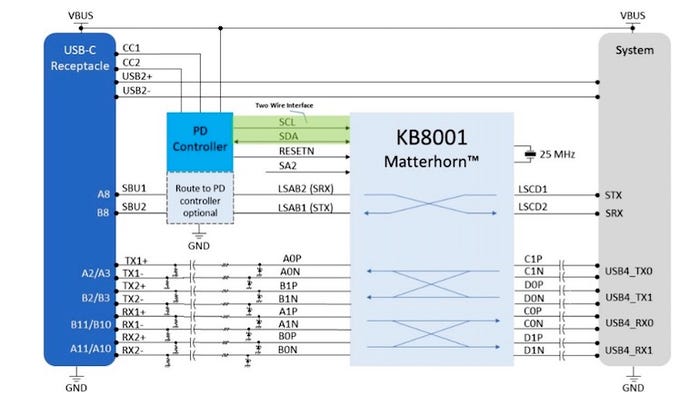New USB Connectivity Standard Mandates a Retimer. You Should Know Why and How 61275
The latest standard USB standard requires a retimer chip. Why is that so?
August 13, 2021

There is a new connectivity standard from the USB Implementers Forum (USB-IF) known as USB4. The new update mandates the use of a retimer chip in front of every USB-C port, a market estimated to exceed $1 billion. Targeted consumer applications include desktop and mobile PCs, tablets, and peripheral devices.
A typical retimer can extract the embedded clock signal from a high-speed protocol, fully recover the data, and retransmit a fresh copy of the data using a clean clock. Retimers, or redrivers, are often used to reach the furthest corners of a large printed circuit board (PCB), expand to additional connections, support daughter cards, and enhanced various device functions.
To learn more about this important connectivity update, Design News talked with Dr. Amin Shokrollahi, CEO and Founder of Kandou, who will also be attending DesignCon2021. What follows is an edited version of that conversation.
Design News: What is the relationship between USB-C and retimers?
Dr. Amin Shokrollahi: Retimers is the key to most USB-C applications. USB4 requires the use of the USB-C connector. Most USB-C systems are physically large enough to require a retimer to be immediately next to the USB-C connector.
Design News: What new applications are made possible with a retimer?
Dr. Amin Shokrollahi: USB-C is currently in everything from high-performance laptops to combination battery/hand warmers. Retimers will be needed in many USB4 applications of USB-C. USB4 will extend USB-C’s use in high-performance applications. Early adopters will certainly include bandwidth-hungry SSD drives. Thunderbolt 4 leverages USB4 to drive dual 4K displays.
Design News: How will this update fit into the evolving IoT space?
Dr. Amin Shokrollahi: When people think of IoT systems, they think of physically small units. These small units may indeed be able to get by without a retimer. However, many IoT systems are not small at all. For example, some industrial control modules are actually large and will need retimers next to each of their USB-C ports. Even small IoT systems may need a retimer because their USB interface may not be certified as USB4 compliant. A retimer can provide the elaborate equalization resources and registers required to satisfy the USB-IF with otherwise incompatible microprocessors.
Design News: Please tell us about the Matterhorn technology.
Dr. Amin Shokrollahi: The Matterhorn KB8001 is a USB-C multiprotocol retimer package with USB4 support. It uses our low-power SerDes technology to extend the length of PCB traces while maintaining low latency. It can be located up to approximately 16 inches (or 40 centimeters) away from the main host SoC using low-cost PCB materials while preserving signal integrity. The result is reduced overall system and development costs. (Image Source: Kandou)
To register for DesignCon, please click here.

John Blyler is a Design News senior editor, covering the electronics and advanced manufacturing spaces. With a BS in Engineering Physics and an MS in Electrical Engineering, he has years of hardware-software-network systems experience as an editor and engineer within the advanced manufacturing, IoT and semiconductor industries. John has co-authored books related to system engineering and electronics for IEEE, Wiley, and Elsevier.
About the Author(s)
You May Also Like





